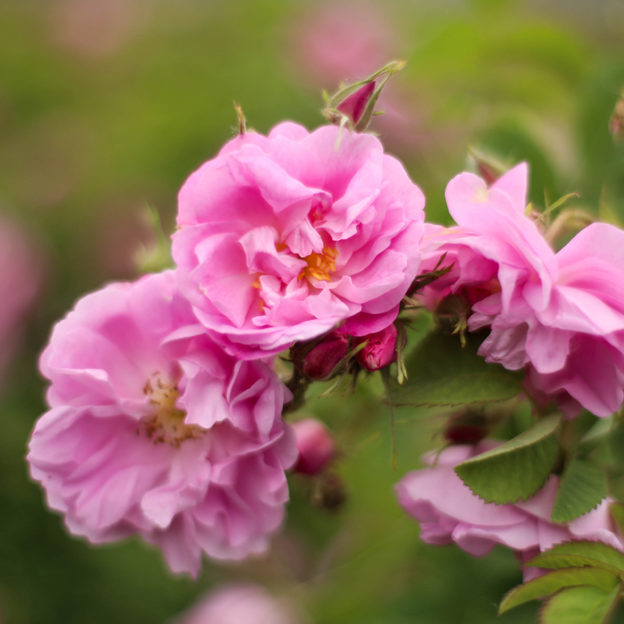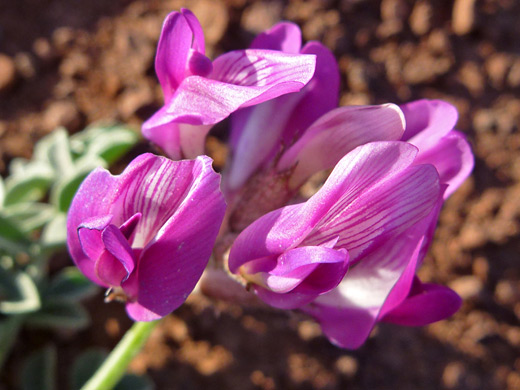The distribution of vegetation in the Rocky Mountains correlates directly to elevational changes, which influence the temperature and availability of moisture. Different plant communities characterize each zone (such as foothill, montane, subalpine, and alpine) from the base of a mountain to the top, and each zone may contain several types of plant communities. More than 5,000 plant species occur in the Rocky Mountains. The wildflowers begin to bloom in early spring, as soon as the snow starts to melt. The peak bloom season is mid-summer. This collection highlights some of the most common wildflowers found in the Rocky Mountains.
My favorite Colorado Wild flower is The Wild Colorado Rose.
What’s yours?
One of the main benefits of rose water is that it acts as an anti-inflammatory, soothing irritated skin. Some people also use roses as a rich source of antioxidants, which can helps strengthen skin cells and regenerate skin tissue. These properties, proponents believe, maker rose water particularly beneficial to people with sensitive skin. Some experts even believe that rose water or products with rose extracts can play a role in reducing damage from sun exposure. Too much sun destroys elastin, the fibers that give your skin its ability to stretch.When those fibers break down, they cause your skin to lose firmness and sag. There’s some evidence that rose water may help decrease damage to the skin’s elastin fibers and prevent wrinkles, but researchers are still testing this theory.
Wild Rose is a natural mild antiseptic and is recommended for acne and skin irritation, for
nourishing and hydrating the skin and face, and for nourishing the body after a shower or bath.
Rose stimulates the circulation in the tiny blood vessels beneath the skin, helping to reduce
the appearance of thread veins and broken capillaries. It stimulates the regeneration process
and has a calming effect on acne, dermatitis, psoriasis and eczema. Regular use of rose
infused products, like Earth Tone, will help prevent these conditions from occurring and soothe
the skin when they do occur. “Studies were done in Japan that showed rose extracts help with damage to collagen and elastin,” Dr. Colbert said. “Besides, the aromatic qualities of rose affect the brain’s limbic system, and your brain helps control your skin. Any positive association ( such as the rose scent being soothing) will help your complexion.”
Since rose has anti-inflammatory properties, using rose extracts can help in reducing the redness from irritated or over-heated skin. We use wild roses that we’ve picked from the mountains in Colorado and have infused Apple Cider Vinegar with the buds to make our Earth Tone, herbal skin toner.
It is a great cleanser and aids in removing oil and dirt accumulated in clogged pores. Thus preventing acne and pimples.
It has astringent like properties, which is why it is awesome to use after washing-up to close open pores. Applying rose after steaming tightens capillaries, reduces redness and blotchiness.
The aroma of roses is said to be a powerful mood enhancer. It rids you of feelings of anxiety and promotes emotional wellbeing, thereby making you look relaxed. Since it is de-stressing, it helps you sleep better which means you will wake up feeling fresh.
The use of the rose is far and varied. It has a long history in its use in folk remedies, especially in the area of skincare. It is suitable for all skin types, but it is especially valuable for dry, sensitive or aging skins. It has a tonic and astringent effect on the capillaries just below the skin surface, which makes it useful in diminishing the redness caused by enlarged capillaries.
The best way to use it is to apply it at night. It helps clear all impurities that your face has collected through the day.
Here are the rest of the Colorado Wild Flowers.Enjoy
 Common Harebell (Campanula rotundifolia), family Campanulaceae (Bellflower).
Common Harebell (Campanula rotundifolia), family Campanulaceae (Bellflower).
This is a flower that is easy on the eyes. Simple, but an especially pretty shade of blue. The flowers prefer an elevation of less than 8000 feet, making a more likely sighting for us low altitude hikers. The genus is another of the huge groups. There are approximately 300 species, with subspecies in the numbers as well. One of the more famous associations of origins of the plant is the Scottish Bluebell. The plant is described as showing in white and purple in addition to the blue. Common harebell is native to temperate North America.
 Alpine Forget-Me-Not (Eritrichium nanum var. elongatum) family Boraginaceae (Borage).
Alpine Forget-Me-Not (Eritrichium nanum var. elongatum) family Boraginaceae (Borage).
Another example of a delicate looking plant that is a power-house for survival, the harsh environment that hosts this plant can be relentless. It survives and flourishes at high altitudes with attitude. An interesting trait of these plants is that the plants produce flowers of different sizes to decrease chances of inbreeding. The larger flowers are male, with the smaller being female; plants are either one or the other. In the male flowers the stamens stick out past the stigma. The stigmas of female flowers are larger. These plants grow very close to the ground. The harsh effects of the high winds that can be common in the alpine habitat are thus minimized. This spcies is another celebrity plant. It is the state flower of Alaska. The Borage family hosts about 100 genus with approximately 2000 species.
 Blackeyed Susan (Rudbeckia hirta), family Asteraceae (Aster/Sunflower)
Blackeyed Susan (Rudbeckia hirta), family Asteraceae (Aster/Sunflower)
This beautiful and showy species has many common names, almost TOO many: Black-eyed Susan, Blackiehead, Brown Betty, Brown Daisy, Gloriosa Daisy, Golden Jerusalem, Poorland Daisy, Yellow Daisy, and Yellow Ox-eye Daisy. The species is native to North America and was named the state flower of Maryland in 1918. There are slightly over 20 species in this genus. As with Rudbeckia laciniata, this species is said to possibly be toxic to cattle, sheep and pigs. The flowers are annual/biennial/perennial herbs.

Simpson Hedgehog Cactus Flowers
Pediocactus simpsonii
Pediocactus simpsonii is an early blooming member of the cactus family (Cactacae), usually showing flowers from early May to June. Its flowers range in color from white to a very dark pink, and add a splash of color on rocky soils and exposed ridges where most plants have a tough time establishing.

Claytonia lanceolata is a small plant, usually with just two opposite leaves, growing a little way up the short stem, which is topped by a small number (3 to 20) of pretty white or pinkish flowers. One or two basal leaves may be present early in the season. Flowers consist of two sepals and five petals which have a few thin purplish lines radiating lengthways, and patches of yellow at the base. At the center are five white stamens supporting pink anthers, and a white stigma. The plant is one of the earliest to bloom in its habitat of foothills and mountains, often just as the winter snows have melted. It grows from a spherical, edible tuber deep underground.

Castilleja, commonly known as Indian paintbrush or prairie-fire, is a genus of about 200 species of annual and perennial herbaceous plants native to the west of the Americas from Alaska south to the Andes, northern Asia, and one species as far west as the Kola Peninsula in northwestern Russia. These plants are classified in the broomrape family, Orobanchaceae (following major rearrangements of the order Lamiales starting around 2001; sources which do not follow these reclassifications may place them in the Scrophulariaceae). They are hemiparasitic on the roots of grasses and forbs. The generic name honors Spanish botanist Domingo Castillejo.[2]
The pinnately compound leaves provide one means of distinguishing astragalus amphioxys from the many other similar species in this genus; they are small, grey-green, covered in short silky hairs that lie flat against the surface, and grow in opposite, upwards-angled pairs along an arching stalk. Another identifying feature is the seed pod, which is (usually) arched to form a semi-circle and has its lower seam at the base of a groove rather than a protruding ridge. Pods have a mottled appearance; patches of red on a greenish-yellow background. Flowers are about an inch in length, with the outsides also somewhat hairy. The upper banner petal is curved backwards, but not as strongly as for some other species. The edges of the banner are folded back, and its center is lighter in color. Petals become blue as they wither. There are four varieties (amphioxys, modestus, musimonum, vespertinus).
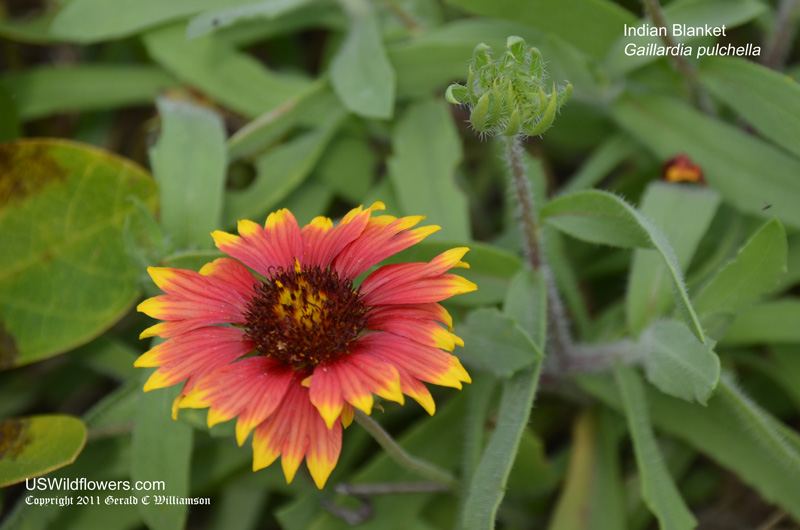
The blossoms of Indian Blanket are up to about 2.5 inches across. The ray flowers are normally yellow at their tips and red at their base, with the red frequently grading from an orange-red near the yellow tips. Rarely the rays flowers may be a solid orange or solid yellow. There may be up to 100 disk flowers which are a brownish-red
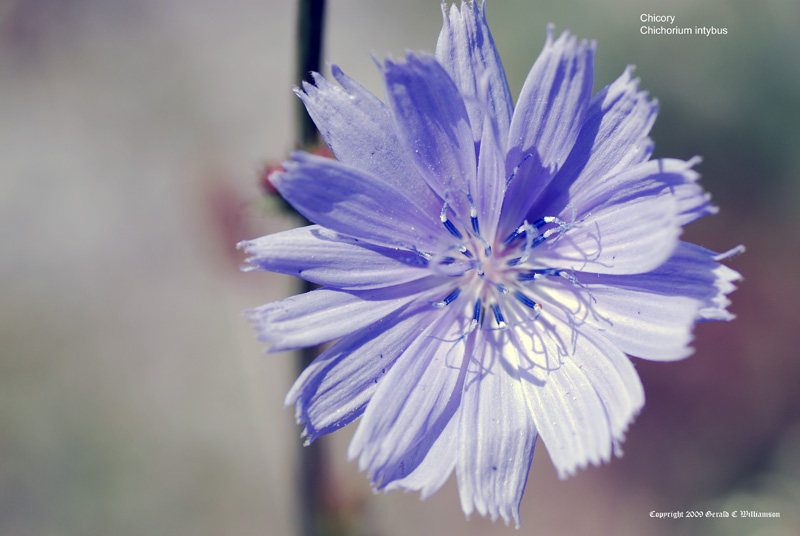
Chicory, Cichorium intybus,
This plant in the aster family (Asteraceae) has been cultivated for centuries for its leaves, buds and roots, and was used medicinally. The young leaves of even the wild type can be eaten raw as a salad green with a very bitter taste or older leaves can be cooked to reduce the bitterness. Common names for the cultivated types (var. foliosum) include Belgian endive, French endive, radicchio, red endive, sugarloaf, or witloof. These are very different from the wild type and are not discussed in this article. The processed roots of the variety sativum are still used mixed with or as a coffee substitute in some parts of the world including the southern US, especially in New Orleans. The plant is also used as a forage crop in some parts of the world. Because of its toxicity to internal parasites, there has been some research investigating using this plant as a forage to reduce worms in livestock, especially sheep.
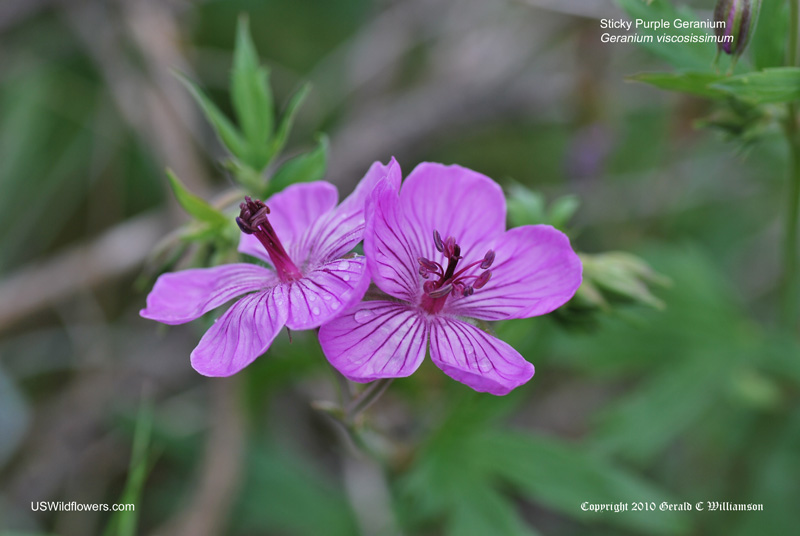
Growth Characteristics: A flowering forb, growing 20-50 inches tall, with 1 to a few stems. Stems are stout, forked, and hairy. Flowers May to August, fruits mature August to September, it reproduces by seed.
Flowers: Sticky Geranium has two to several flowers in open clusters, often 2-forked well above the leaves. The flowers have five sepals and five petals. Petals are long, rounded to slightly notched, pinkish-lavender to purplish, seldom white, and soft long-hairy at the base for about ¼ of the length. The 10 filaments are joined at the base.

Arrival of the genus Aquilegia into North America is a recent event occurring 10,000 to 40,000 years ago during the Pleistocene. Columbines crossed into North America from Asia over the Bering land bridge that connected the two continents during that period. A progenitor columbine began to radiate rapidly out of Alaska and throughout the North American continent. As the columbines were moving through out the continent, new species developed.
As with Darwin’s finches, columbines developed similar but differently shaped and colored flowers in response to newly encountered habitats and pollinators. They developed different positions for presenting their flowers, sepals, and spurs, and different spur shapes in response to their primary pollinator.

